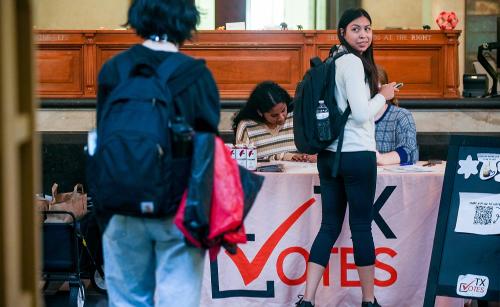Recently I asked Homeland Security Director Tom Ridge which of our two borders concerns him most:
Our lightly supervised northern border where Canada hosts more than 50 terrorist groups and a large Muslim population, or our southern border with its heavy flow of illegal immigrants and a culture of bribery in Mexico’s law enforcement agencies.
After giving due weight to the serious problems emanating from the north, he answered: Mexico.
After Sept. 11, for the first time since our Revolutionary War, we cast an anxious eye on our Canadian border. Canada’s Security Intelligence Service has found that terrorists recently moved “from significant support roles, such as fund-raising and procurement, to actually planning and preparing terrorist acts from Canadian territory.”
Yet Canada will clean up its act more rapidly than can Mexico in view of the latter’s legendary official corruption. American security officials are concerned that al-Qaida will turn its attention to our porous southern border and our vulnerable Latin America strategic rear.
In global conflict our adversary never fails to try our Latin American back door. Each time the crack widens. In World War I, Germany offered to return conquered U.S. territory to Mexico in return for attacking and tying down the U.S. The Nazis built networks in German communities in South America. The Soviets armed Cuba and Grenada and meddled in Central America.
Latin America affords terrorist networks promising avenues: a long, disorderly border; corrupt officials, well-organized smuggling rings. Endemic official graft makes it easy to obtain travel documents. Police forces are often inefficient and corrupt; police officials often run criminal gangs.
Latin America’s problematic transition to democracy and markets has deepened the inequality that helps perpetuate anti-American sentiment. And terrorism is now on the rebound in Peru and on the offensive in Colombia.
There is nothing to indicate a direct alliance between al-Qaida and Latin American terrorist organizations like Colombia’s FARC or the Shining Path in Peru. But U.S. counterterrorism experts say “sleeper cells” have been planted among Latin America’s 6 million Muslims.
After Sept. 11 about 40 FBI agents and police officers from Argentina and Brazil scoured Paraguay’s notorious “triple border” region that has become a haven for Islamic terrorists. U.S. authorities have asked government security forces in Argentina, Brazil, Colombia, Ecuador and Uruguay to track movements of suspect Arab nationals in the wake of the attacks.
The Bush administration suspects that the Abdullah ring, which specializes in smuggling Middle Easterners over the Mexican border, has terrorist ties. Thanks to international smugglers, the number of Middle Easterners illegally crossing Mexico’s borders has soared. Mexican drug lords have tunneled the border and set up clandestine methamphetamine factories in various parts of the United States. The State Department’s coordinator for counterterrorism recently told a congressional committee that the Mexican border represents a “diffuse and insidious threat.”
The answer is not to “close down” that border, were that even possible, and thus to junk NAFTA and tip Mexico and the Southwest and into economic crisis. Together with Mexico we should fashion a “smart border” with pre-clearance for goods, fast lanes for frequent travelers and modern detection devises. Everyone crossing should be checked through a comprehensive database. Illegal migration is a luxury we can no longer afford. But to bring it to an end it we ought also to reconsider a Mexican proposal for bilateral cooperation that looked to be a dead letter after Sept. 11. That is what President Bush should do when he meets with Mexican counterpart Vicente Fox in Monterrey, Mexico, on Friday.
Mexico wishes to make migration legal and orderly, replacing smugglers and illegal immigrants with guest workers and legal residents. The alternative is to try to deport unauthorized immigrants and to try to staff the entire Mexican border, even as we increase supervision in the north.
Those missions could bust an already overtaxed Immigration and Naturalization Service and foster a scofflaw migrant environment hospitable to terrorists. Who is going to report suspicious activity to the authorities if they believe their own deportation will follow? For the system to work, two more things are needed. The first is to issue identity cards to an agreed number of migrants and undocumented workers. The second is that Mexico share responsibility for our common border and extend the security perimeter against terrorism by building the rule of law within Mexico.
Several indices show that the Border Patrol has enjoyed some success in stemming the flow of illegal immigrants, but unfortunately “success” has cost a significant toll in Mexican lives. However, were Mexico to place dangerous zones off-limits, together we could make the border safe. Mexican criminal organizations hospitable to international terrorists are a menace to both our countries. Building the rule of law is the centerpiece of Fox’s administration, which has just achieved a signal victory over the notorious Arellano cartel.
Bush’s visit to Mexico is intended to back his affirmation that Mexico remains a top priority despite Sept. 11. In fact, Mexico is now more critical to the United States. If our back door is not to remain open to terrorists, we need Mexico’s cooperation. A Mexican immigration accord would be a first step toward closing our back door, but gently.


Commentary
Op-edImmigration Accord Would Help Mexico Lock Our ‘Back Door’
March 18, 2002